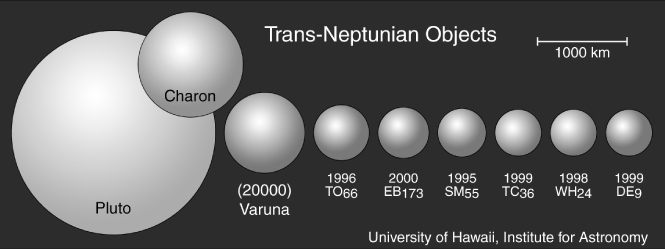
|
SIZE AND ALBEDO OF KUIPER BELT OBJECT (20000) VARUNA
Institute for Astronomy, University of Hawaii and Aaron Evans Dept. Physics and Astronomy, State University of New York at Stony Brook NATURE, 2001, 411, 446-447 (May 24 issue)
|
|---|
Abstract
Observations within the last decade have revealed the existence of a
large number of bodies in orbit about the sun beyond Neptune. These
bodies, commonly known as Kuiper Belt Objects (KBOs), are products of
agglomeration in the rarefied outer regions of the protoplanetary disk
of the sun. Scientific interest focuses on the primitive nature of the
KBOs and on their role as the likely source of short-period comets.
Unfortunately, the KBOs are difficult astronomical targets, so that
even such basic physical properties as the sizes and albedos remain
unknown. Here we report the first simultaneous thermal and optical
measurements of a bright KBO and use them to solve separately for the
albedo and size. (20000) Varuna has equivalent circular diameter D =
900(+125/-145) km and red geometric albedo p = 0.070(+0.030/-0.017).
The surface is darker than Pluto, suggesting a composition largely
devoid of fresh ice, but higher than the canonical albedo of 0.04
previously assumed for these bodies.

|
The individual pictures from Day 1 (2001 Apr 24) and Day 2 (2001 Apr 25). Images by Scott Sheppard.
The PS version of the paper and the PDF version, too..
The editorial by Tegler and Romanishin and the Trout piece.
Additional Figures from the paper:
PS Figure 1, PDF Figure 1 and PS Figure 2, PDF Figure 2.
After we measured the size, we went back to measure the rotation period and shape of Varuna. To our surprise, we were able to estimate the density of the object. The low value (1000 kg per m**3) is due to internal porosity. The resulting paper is here as a PDF.
Last updated May 2002